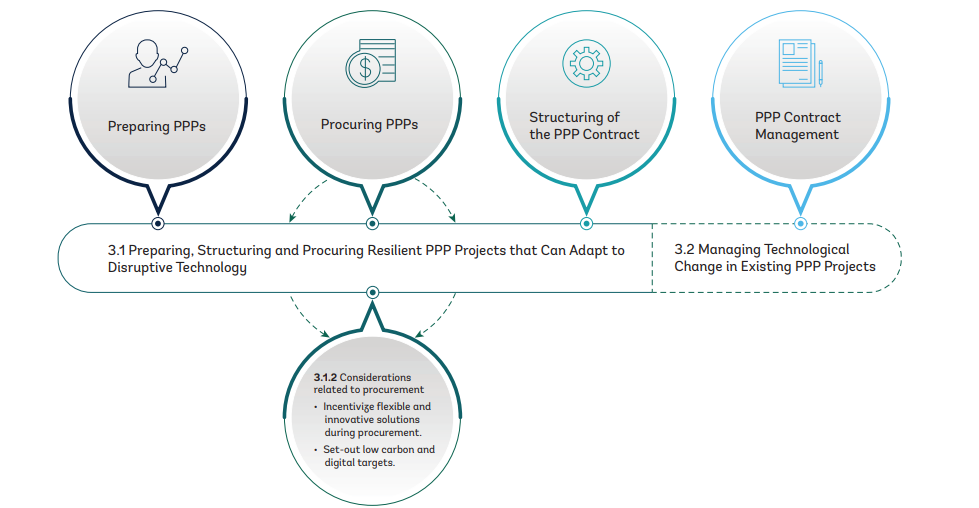Considerations Related to Procurement

Photo Credit: Image by Pixabay
On this page: Procurement of infrastructure PPPs typically provides limited flexibility to modify the project if the external conditions change after delivery. In order to achieve more flexibility, a view across the entire life cycle of the project is helpful for the procurement of PPP projects.
Procurement of infrastructure PPPs typically provides limited flexibility to modify the project if the external conditions change after delivery (see Section 4.2 for details). For example, the pricing scheme of an energy project cannot simply be adjusted if the forecasted demand changes after the project has been implemented. In order to achieve more flexibility, a view across the entire life cycle of the project is helpful for the procurement of PPP projects. This means as a first step that the various assessments undertaken during the project preparation stage, that did consider potential developments related to disruptive technologies, should inform the tender requirements specified by the contracting authority, as well as the terms of the PPP contract. If a project takes place in a sector where a high risk for technological change and obsolescence has been identified— due to fast-paced technological changes in a specific sector or in relation to a specific asset type or technology envisaged—governments may want to develop and use new procurement approaches. The aim of these models is to move away from the use of lowest-cost procurement, which often does not take into account the use of the best technology and the costs associated with effectively implementing these projects.1 Innovative solutions can, for example, be encouraged through approaches that set out low-carbon or digital targets; focus on VfM and life-cycle costs; introduce collaborative procurement methods, including contracting approaches for procurement that allow bidders to prepare alternative proposals; or separate technical and pricing aspects of bids.2 Box 4: Encouraging Innovation through Procurement: Alternative Technical Concepts (ATCs) in the United States The use of ATCs has become a standard practice for design-build and PPP transportation projects in the United States. The practice allows bidders to modify technical requirements by allowing proposers to confidentially propose innovations and technical enhancements that would not otherwise comply with the request for proposal (RFP) requirements in a pre-proposal ATC process. If the contracting authority approves a proposer’s ATC, the proposer has the right to submit a proposal that incorporates the approved deviation from the technical requirements without concern that its proposal will be rejected as non-conforming. ATCs encourage innovation by obtaining competitive pricing for innovation and reducing the risk of outdated design. Source: US Department of Transportation. 2019. Public-Private Partnership (P3) Procurement: A Guide for Public Owners. See also “Case Study 5: United States, Maryland — The I-495 & I-270 PPP Highway Project.” This project used an innovative dialogue process to incentivize innovation beyond the wording of the RFP requirements and a comprehensive public engagement process. Where a high risk of stranded assets has been identified, the tender can be designed in a way that the quality of the technical solution and its flexibility to adapt to a changing technological landscape is considered. This may require a separation of the technical and pricing aspects of bids. Box 5: Broadband PPP Project in Meurthe-et-Moselle, France: Importance of Award Criteria in the Face of Rapid Technological Change The award criteria for the broadband project in Meurthe-et-Moselle emphasized the speed factor in achieving the desired geographical coverage, but no points were awarded for the quality of the technical solutions proposed by the tenderers. Consequently, although 95 percent of the households have been covered at six megabits per second (Mbps), in many cases this comes through satellite or Wi-Fi-MAX, less durable and less high-performing technologies that are not in line with the tendency to expand the coverage of households with fiber optic. Considerable additional resources have therefore had to be set aside in order to update network quality on a regular basis, so that the cost of major infrastructure maintenance and renewal (€32 million) accounts for 84.4 percent of the total project investment cost of €37 million—a considerably higher proportion than in other broadband projects which use fiber optics more intensively. Source: European Court of Auditors. 2018. Public Private Partnerships in the EU: Widespread shortcomings and limited benefits. It is strongly recommended that competitive procurement methods are used to select the investor whenever feasible,3 including through innovative methods of price competition, such as auctions.4 However, a direct contracting model may sometimes work better for the development of innovative solutions in less mature PPP markets—if market interest is low and local capacity may not be sufficient to procure and deliver complex PPP projects. More generally, governments might benefit from building a process that allows them to receive unsolicited proposals because this can help ensure that the use of innovative technology is not inadvertently prevented by a rigid procurement structure.5 More generally, the introduction of outcome-based procurement frameworks that align the objectives of both the planning authorities and the private sector organizations and ensure the achievement of other benefits envisaged by the public sector, such as delivery of environmental and social impacts, may be beneficial to encourage the adoption of InfraTech.6 Footnote 1: World Bank Group. 2020. Infratech Policy Toolkit. Footnote 2: World Bank Group. 2020. Infratech Value Drivers. Footnote 3: For unsolicited proposals (USPs), it is recommended that the project is still in some way open for other parties to compete. For details, see the World Bank Group and PPIAF’s Policy Guidelines for Managing Unsolicited Proposals, Volumes I–III. Footnote 4: Solar auctions, for example, have been very successful at achieving record-breaking low PPA prices for the government (to the point where it must also be considered whether such prices are sustainable in the longer term, given the low margins being accepted by developers). Nonetheless, it has been shown that competitive methods are effective at bringing value for money for the contracting authority. Footnote 5: World Bank Group. 2020. Infratech Policy Toolkit. Footnote 6: Promoting InfraTech adoption across the Infrastructure lifecycle, PwC and Global Infrastructure Facility (GIF) 2021.

The Disruption and PPPs section is based on the Report "PPP Contracts in An Age of Disruption" and will be reviewed at regular intervals.
For feedback on the content of this section of the website or suggestions for links or materials that could be included, please contact the Public-Private Partnership Resource Center at ppp@worldbank.org.
Updated: